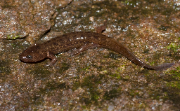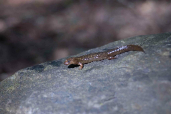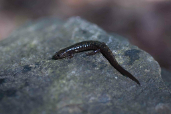Central Shovel-Nosed Dusky Salamander (D. intermedius)
Description: Also called the Black Shovel-nosed Salamander. The shovelnose salamander is a robust species, broad with a relatively short tail. It receives its name from the shape of its snout which is more square ended than is seen in other salamanders in its genus. The colour is a dusky brown, grey, or black with two longitudinal rows of paler small patches and many smaller pale speckles. The underside is usually grey.
Habitat: As with all Shovel-nosed Salamanders,t his species occurs almost exclusively in the rocky riffle zones of fast-flowing, high-gradient mountain streams. There is little ecological information available that is specific to this species, although it is expected to be similar to Desmognathus marmoratus. Therefore, it is thought to inhabit cool, small to medium-sized upland streams or spring runs. It is not likely to be tolerant to habitat disturbance, such as siltation
Range: This species occurs on the west side of the continental divide in the Appalachian Nantahala drainage of eastern Tennessee and North Carolina .
Found in these States:
NC |
TN
Diet: Shovel-nosed salamanders consume primarily aquatic invertebrates but will occasionally consume smaller salamanders
Reproduction: Breeding takes place in late spring and early summer. The female attaches eggs singly or in small clumps to the underside of a rock in moving water. The eggs hatch after about eleven weeks and the larvae hide among the gravel particles and feed on aquatic invertebrates. They undergo metamorphosis into adults at two to three years of age and mature at about five.
Status: Listed as Data Deficient since there is very little information on its extent of occurrence, population status, ecological requirements, and threats. While the life history and ecology can be assumed to be similar to the parent species, it is unclear if this species occurs in any protected areas or if it is impacted by any of the threats outlined for the parent species, Desdmognathus marmoratus. The parent species is largely absent from streams that have been heavily silted, but the water quality of the streams within this species' range is unknown. Without this information, it is difficult to know if the species is well-protected or threatened. This degree of uncertainty makes it difficult to discern if this species could qualify for a threatened category or is suitable for Least Concern, therefore Data Deficient is the most appropriate category.
»» Kingdom: Animalia - Animals
»» Phylum: Chordata - Chordates
»» Subphylum: Vertebrata - Vertebrates
»» Class: Amphibia - (Amphibians)
»» Order: Caudata - Salamanders
»» Family: Plethodontidae - Lungless Salamanders
»» Genus: Desmognathus
»» Species: D. intermedius - Central Shovel-Nosed Dusky Salamander
This article uses material from the Wikipedia article "Shovel-Nosed Salamander", which is released under the Creative Commons Attribution-Share-Alike License 3.0. Content may have been omitted from the original, but no content has been changed or extended.
|













